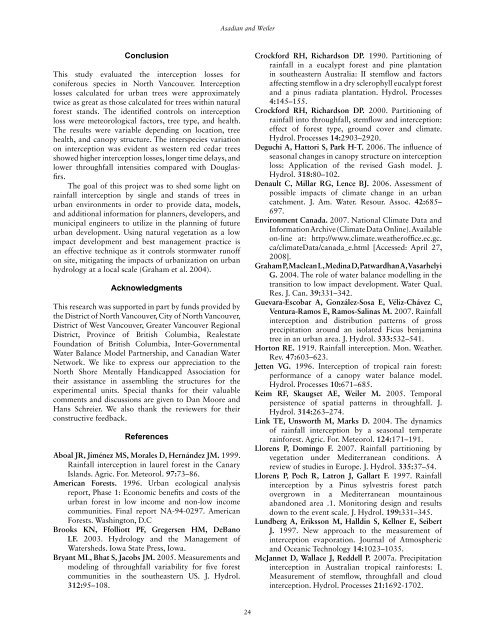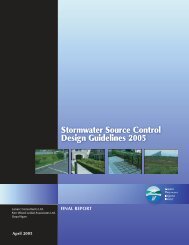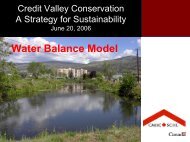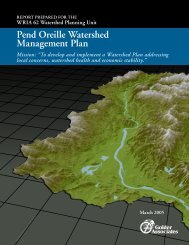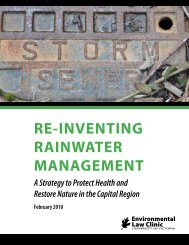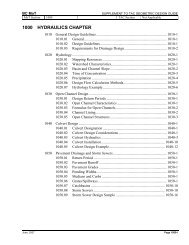A New Approach in Measuring Rainfall Interception by Urban Trees ...
A New Approach in Measuring Rainfall Interception by Urban Trees ...
A New Approach in Measuring Rainfall Interception by Urban Trees ...
You also want an ePaper? Increase the reach of your titles
YUMPU automatically turns print PDFs into web optimized ePapers that Google loves.
Asadian and Weiler<br />
Conclusion<br />
This study evaluated the <strong>in</strong>terception losses for<br />
coniferous species <strong>in</strong> North Vancouver. <strong>Interception</strong><br />
losses calculated for urban trees were approximately<br />
twice as great as those calculated for trees with<strong>in</strong> natural<br />
forest stands. The identified controls on <strong>in</strong>terception<br />
loss were meteorological factors, tree type, and health.<br />
The results were variable depend<strong>in</strong>g on location, tree<br />
health, and canopy structure. The <strong>in</strong>terspecies variation<br />
on <strong>in</strong>terception was evident as western red cedar trees<br />
showed higher <strong>in</strong>terception losses, longer time delays, and<br />
lower throughfall <strong>in</strong>tensities compared with Douglasfirs.<br />
The goal of this project was to shed some light on<br />
ra<strong>in</strong>fall <strong>in</strong>terception <strong>by</strong> s<strong>in</strong>gle and stands of trees <strong>in</strong><br />
urban environments <strong>in</strong> order to provide data, models,<br />
and additional <strong>in</strong>formation for planners, developers, and<br />
municipal eng<strong>in</strong>eers to utilize <strong>in</strong> the plann<strong>in</strong>g of future<br />
urban development. Us<strong>in</strong>g natural vegetation as a low<br />
impact development and best management practice is<br />
an effective technique as it controls stormwater runoff<br />
on site, mitigat<strong>in</strong>g the impacts of urbanization on urban<br />
hydrology at a local scale (Graham et al. 2004).<br />
Acknowledgments<br />
This research was supported <strong>in</strong> part <strong>by</strong> funds provided <strong>by</strong><br />
the District of North Vancouver, City of North Vancouver,<br />
District of West Vancouver, Greater Vancouver Regional<br />
District, Prov<strong>in</strong>ce of British Columbia, Realestate<br />
Foundation of British Columbia, Inter-Governmental<br />
Water Balance Model Partnership, and Canadian Water<br />
Network. We like to express our appreciation to the<br />
North Shore Mentally Handicapped Association for<br />
their assistance <strong>in</strong> assembl<strong>in</strong>g the structures for the<br />
experimental units. Special thanks for their valuable<br />
comments and discussions are given to Dan Moore and<br />
Hans Schreier. We also thank the reviewers for their<br />
constructive feedback.<br />
References<br />
Aboal JR, Jiménez MS, Morales D, Hernández JM. 1999.<br />
Ra<strong>in</strong>fall <strong>in</strong>terception <strong>in</strong> laurel forest <strong>in</strong> the Canary<br />
Islands. Agric. For. Meteorol. 97:73–86.<br />
American Forests. 1996. <strong>Urban</strong> ecological analysis<br />
report, Phase 1: Economic benefits and costs of the<br />
urban forest <strong>in</strong> low <strong>in</strong>come and non-low <strong>in</strong>come<br />
communities. F<strong>in</strong>al report NA-94-0297. American<br />
Forests. Wash<strong>in</strong>gton, D.C<br />
Brooks KN, Ffolliott PF, Gregersen HM, DeBano<br />
LF. 2003. Hydrology and the Management of<br />
Watersheds. Iowa State Press, Iowa.<br />
Bryant ML, Bhat S, Jacobs JM. 2005. Measurements and<br />
model<strong>in</strong>g of throughfall variability for five forest<br />
communities <strong>in</strong> the southeastern US. J. Hydrol.<br />
312:95–108.<br />
Crockford RH, Richardson DP. 1990. Partition<strong>in</strong>g of<br />
ra<strong>in</strong>fall <strong>in</strong> a eucalypt forest and p<strong>in</strong>e plantation<br />
<strong>in</strong> southeastern Australia: II stemflow and factors<br />
affect<strong>in</strong>g stemflow <strong>in</strong> a dry sclerophyll eucalypt forest<br />
and a p<strong>in</strong>us radiata plantation. Hydrol. Processes<br />
4:145–155.<br />
Crockford RH, Richardson DP. 2000. Partition<strong>in</strong>g of<br />
ra<strong>in</strong>fall <strong>in</strong>to throughfall, stemflow and <strong>in</strong>terception:<br />
effect of forest type, ground cover and climate.<br />
Hydrol. Processes 14:2903–2920.<br />
Deguchi A, Hattori S, Park H-T. 2006. The <strong>in</strong>fluence of<br />
seasonal changes <strong>in</strong> canopy structure on <strong>in</strong>terception<br />
loss: Application of the revised Gash model. J.<br />
Hydrol. 318:80–102.<br />
Denault C, Millar RG, Lence BJ. 2006. Assessment of<br />
possible impacts of climate change <strong>in</strong> an urban<br />
catchment. J. Am. Water. Resour. Assoc. 42:685–<br />
697.<br />
Environment Canada. 2007. National Climate Data and<br />
Information Archive (Climate Data Onl<strong>in</strong>e). Available<br />
on-l<strong>in</strong>e at: http://www.climate.weatheroffice.ec.gc.<br />
ca/climateData/canada_e.html [Accessed: April 27,<br />
2008].<br />
Graham P, Maclean L, Med<strong>in</strong>a D, Patwardhan A, Vasarhelyi<br />
G. 2004. The role of water balance modell<strong>in</strong>g <strong>in</strong> the<br />
transition to low impact development. Water Qual.<br />
Res. J. Can. 39:331–342.<br />
Guevara-Escobar A, González-Sosa E, Véliz-Chávez C,<br />
Ventura-Ramos E, Ramos-Sal<strong>in</strong>as M. 2007. Ra<strong>in</strong>fall<br />
<strong>in</strong>terception and distribution patterns of gross<br />
precipitation around an isolated Ficus benjam<strong>in</strong>a<br />
tree <strong>in</strong> an urban area. J. Hydrol. 333:532–541.<br />
Horton RE. 1919. Ra<strong>in</strong>fall <strong>in</strong>terception. Mon. Weather.<br />
Rev. 47:603–623.<br />
Jetten VG. 1996. <strong>Interception</strong> of tropical ra<strong>in</strong> forest:<br />
performance of a canopy water balance model.<br />
Hydrol. Processes 10:671–685.<br />
Keim RF, Skaugset AE, Weiler M. 2005. Temporal<br />
persistence of spatial patterns <strong>in</strong> throughfall. J.<br />
Hydrol. 314:263–274.<br />
L<strong>in</strong>k TE, Unsworth M, Marks D. 2004. The dynamics<br />
of ra<strong>in</strong>fall <strong>in</strong>terception <strong>by</strong> a seasonal temperate<br />
ra<strong>in</strong>forest. Agric. For. Meteorol. 124:171–191.<br />
Llorens P, Dom<strong>in</strong>go F. 2007. Ra<strong>in</strong>fall partition<strong>in</strong>g <strong>by</strong><br />
vegetation under Mediterranean conditions. A<br />
review of studies <strong>in</strong> Europe. J. Hydrol. 335:37–54.<br />
Llorens P, Poch R, Latron J, Gallart F. 1997. Ra<strong>in</strong>fall<br />
<strong>in</strong>terception <strong>by</strong> a P<strong>in</strong>us sylvestris forest patch<br />
overgrown <strong>in</strong> a Mediterranean mounta<strong>in</strong>ous<br />
abandoned area .1. Monitor<strong>in</strong>g design and results<br />
down to the event scale. J. Hydrol. 199:331–345.<br />
Lundberg A, Eriksson M, Halld<strong>in</strong> S, Kellner E, Seibert<br />
J. 1997. <strong>New</strong> approach to the measurement of<br />
<strong>in</strong>terception evaporation. Journal of Atmospheric<br />
and Oceanic Technology 14:1023–1035.<br />
McJannet D, Wallace J, Reddell P. 2007a. Precipitation<br />
<strong>in</strong>terception <strong>in</strong> Australian tropical ra<strong>in</strong>forests: I.<br />
Measurement of stemflow, throughfall and cloud<br />
<strong>in</strong>terception. Hydrol. Processes 21:1692-1702.<br />
24


